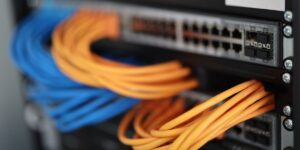This article was first published on Express Computer and written by Shamik Bhattacharya.
The pandemic taught us that reliance on technology was critical to the future. The reliance on all things digital, from our offices to schools to medical consultations, was the final resort. Many organisations and people understood their reliance on digital data centres and data centre services during the epidemic. The education industry was no exception. Data centers are playing an increasingly significant role in transforming education. As technology continues to advance and the demand for digital learning solutions grows, data centers are evolving to support educational institutions in various ways.
 The Internet of Things (IoT), ever-increasing data demands, and continuous cloud use have all led to a move away from traditional approaches. Going back in time, digital transformation got off in its current form approximately ten years ago and has been continuously accelerating since then. Statista predicts that the amount of data created, captured, copied, and consumed worldwide is expected to grow from around 59 ZB in 2020 to around 149 ZB in 2024.
The Internet of Things (IoT), ever-increasing data demands, and continuous cloud use have all led to a move away from traditional approaches. Going back in time, digital transformation got off in its current form approximately ten years ago and has been continuously accelerating since then. Statista predicts that the amount of data created, captured, copied, and consumed worldwide is expected to grow from around 59 ZB in 2020 to around 149 ZB in 2024.
We must recognise that big data and its analytics have addressed the diverse learning demands of various students, in addition to handling the administrative parts of running a school.
These technology behemoths hold the key to systemic change and educational institutions can greatly benefit from them. Numerous advantages enable universities to offer unrivaled student learning experiences. But it’s a known fact that every new venture faces difficulties. Let’s look at some of the advantages that educational institutions can gain from data centres and how they can help education undergo a revolutionary transition that fully realises its potential.
Easy access to content
Data centres are the pinnacle of knowledge. This is precisely what today’s educational institutions, students, and professors need. Resources for education are continuously accessible through data centres. This calls for a strong network design that can manage high traffic volumes, deliver quick connectivity, and guarantee flawless content availability both online and offline. Educational institutions rely on data centers to store and process vast amounts of data, ensuring that students and educators have access to online learning platforms, virtual classrooms, and collaborative tools.
Collection of invaluable data
Data centres would be the go-to source for any information about the college or institution at the touch of a button. Since they are the central system that houses student and teacher information, school records, and other sensitive data like test results, data centres are crucial for schools. In particular, institutions may be able to keep priceless research data that will advance our cause.
Flexible infrastructure
Every educational institution needs data, and for universities, it is their lifeline. Therefore, educational institutions must have a scalable infrastructure to handle the variable demand for planned and unforeseen demand spikes at any given moment in the academic year. This is where data centres come into play since they offer dependable and scalable infrastructure that can support a sizable user base and give them unhindered access to internet content.
Analytics
Educational institutions generate vast amounts of data, including student records, performance metrics, and learning materials. Data centers enable the storage, management, and analysis of this data, unlocking valuable insights to enhance teaching and learning. Through advanced analytics, educators can identify trends, personalise instruction, track student progress, and make data-driven decisions to improve educational outcomes.
Cost optimisation
The majority of education sectors often have extremely small IT budgets. But in the new normal, technology is now crucial to advancing humankind. In these situations, educational institutions and universities have come to understand the value of a data centre. These facilities aid in lowering the cost of data management. Reduced internal costs for purchasing and maintaining pricey equipment like servers and routers. Additionally, since the application and other services are provided as Software as a Service (SaaS), students and teachers can use them as needed without having to purchase the software.
Data privacy
Data centers give utmost importance to security and privacy measures in order to safeguard sensitive educational data. They employ strong security protocols, firewalls, encryption, and access controls to protect student and staff information.
Round-the-clock support
The infrastructure and network layers’ high level of resilience makes sure that the data is securely kept and provided to the authorised user at any time without interruption. The use of data centres also offers continuous technical assistance and upkeep, guaranteeing that the institutions and their students have secure access to data without interruption. By doing this, institutions may keep control over things like power, internet connectivity, fire protection, cooling, and compliance while concentrating on their main tasks.
Disaster recovery and business continuity
Educational institutions handle critical data that needs to be protected in the event of a disaster. Data centers provide robust disaster recovery and backup solutions for educational institutions, safeguarding critical data and ensuring uninterrupted educational services. They employ redundant systems, backup power sources, and geographically distributed data centers to minimize data loss risks and maintain continuous access to educational resources.
Education institutions need to understand that while AI, ML, and the new digital services are exciting, what matters more for the industry is how they can help businesses expand quickly and gain access to better connectivity.
However, technological advancements are still in their infancy and have just recently entered the educational space. Only if other factors like having strong data management in place are taken care of could it successfully continue its journey towards advancement. Due to the widespread usage of digital gadgets, students are also calling for an improved learning environment that incorporates cutting-edge technology.
This article was first published on Express Computer and written by Shamik Bhattacharya.





